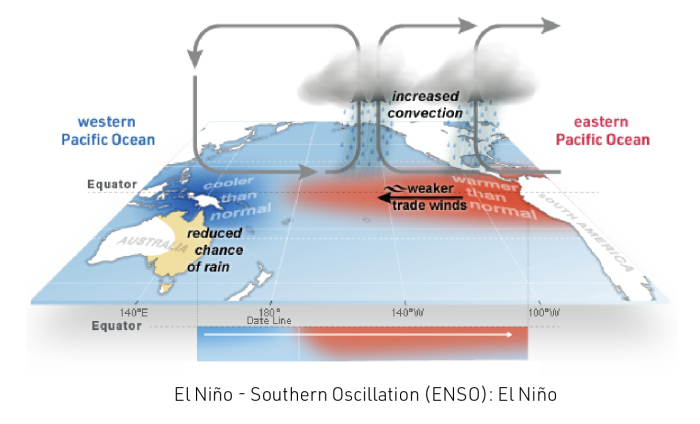Jonathan Brown with Centre researchers.

As the Australian Bureau of Meteorology declares El Niño heading into the 2023/2024 Summer season, climate scientists from the ARC Centre of Excellence have been conducting vital research into the major climate driver.
In a recent briefing, researcher Ruby Lieber explained the basics of El Niño and what it means for Australia.
El Niño is a naturally occurring ocean-atmosphere phenomenon which has major influences on weather and climate in Australia and the globe. During El Niño, there is warming of the sea surface temperatures in the central and eastern Pacific Ocean and cooling to the north of Australia.
What is El Niño’s impact on Australia’s weather and climate? – Briefing note
Lieber says for Australia, this is commonly associated with droughts and bushfires.
“Nine of the ten driest winter-spring periods in southeast Australia occurred during El Niño events. These warmer and drier conditions can increase the risk of drought and bushfire. Most of the major Australian droughts, such as the severe droughts of 1982, 1994, 2002, 2006, and 2015, coincided with El Niño” says Lieber.
Centre researcher Thi Lan Dao led research that found while El Niño usually means hot and dry conditions for much of Australia, some northern areas may experience the opposite.
“In this research we found that during El Niño years, the rainfall response to the Madden-Julian Oscillation is two times stronger than in La Niña years” says Thi Lan Dao.
“What this tells us is that we can’t expect climate processes like the El Niño-Southern Oscillation or Madden-Julian Oscillation to have the same broad impact everywhere. We need location specific information about these interactions to understand the possible impacts on communities.”
Thi Lan Dao – Rainfall relief for Northern Australia during El Niño: New research
And in a paper published in Nature, Dr Georgy Falster’s research found that El Niño and La Niña periods could stick around for longer due to changes in the Pacific Walker Circulation.
In a changing climate, the work of climate scientists is more important than ever as we prepare for periods of El Niño and La Niña into the future.
